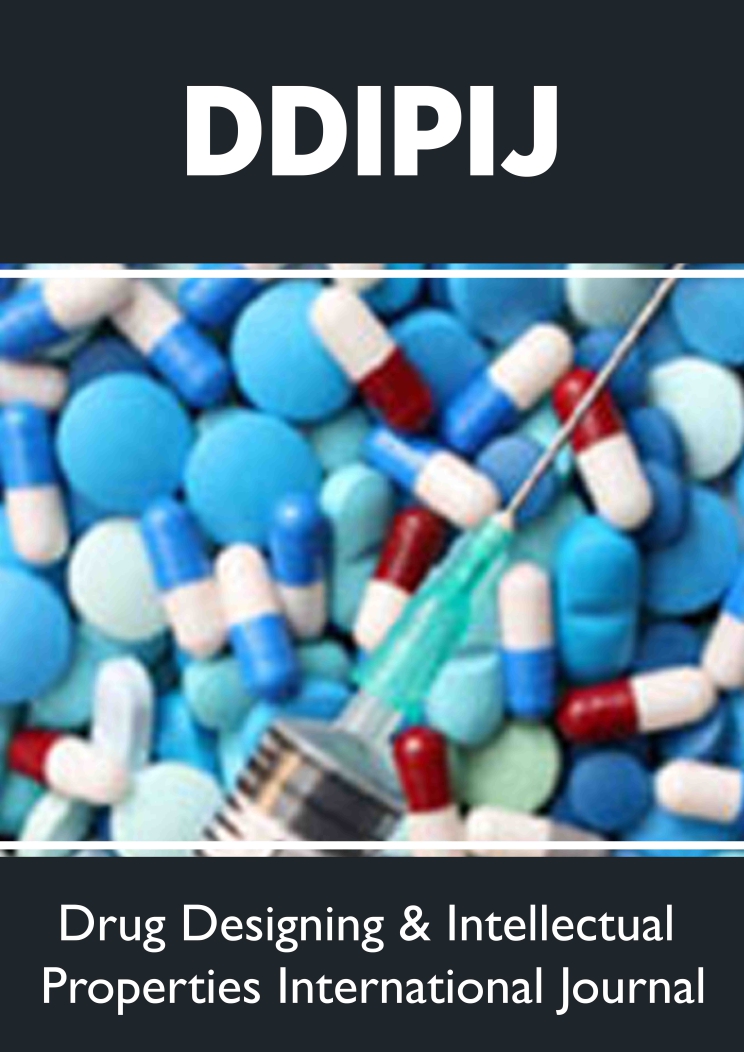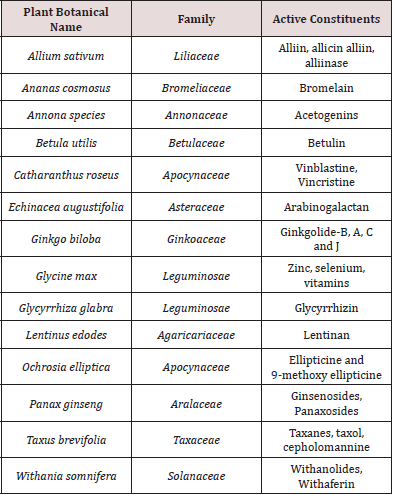Lupine Publishers | Journal of Drug Designing & Intellectual Properties
Abstract
Mankind first medicines were extracts from plants. However, over the years, mankind has resorted to the use of synthetic medicines. Whilst, synthetic medicines have fulfilled their roles and save millions of people around the globe, there is still a need to promote the use of herbal medicines, considering that synthetic medicines have severe side effects when administered and the cost of synthesising drugs, is an expensive endeavors for developing countries like Guyana. Guyana has an adundant of diverse flora, whose extracts have been shown by us and others to have potent and selective antimicrobial activities and antidiabetic activities. However, there is a need to promote the isolation of antimicrobial, antidiabetic and anti-cancer drugs from plants, an elucidation of their structure and modulation of their medicinal activities. This entails significant finance to aid in the purchase of requisite equipment etc. in Novel Drug Discovery. The Guyanese Diaspora and the Entrepreneurship Sector can promote such research in Guyana via the provision of finance to purchase “State of the Art” equipment to conduct such research or the establishment of a National Herbal Research Institute. Such an institute will promote further research on our current herbal medicines and also on the discovery of new Herbal medications.
Keywords: Medicines antimicrobial activities Antidiabetic activities Anti-cancer activities Diaspora Entrepreneurship
Introduction
Mankind first medicines were extracts from plants. Plants have had a long history in modern medicine [1-18]. For example, long before the advent of modern medicine, the Peruvians were fending off malaria with the Cinchona bark from the “quinaquinas” tree. It was given as a cure to a Spanish countess who fell ill with the disease in Lima in around 1630. Then Bernabe Cobo, a Spanish missionary and naturalist was the first to bring the bark to Europe. Quinine was purified from the bark by a team of French pharmacists19. Over the years, mankind has resorted to the use of synthetic medicines. Whilst, synthetic medicines have fulfilled their roles and save millions of people around the globe, there is still a need to promote the use of herbal medicines, considering that synthetic medicines have severe side effects when administered and the cost of synthesising drugs, is an expensive endeavours for developing countries like Guyana.
Antimicrobial endeavours
Guyana, has an adundance of diverse flora, whose extracts have been shown by us and others to have potent and selective antimicrobial activities against human pathogens such as E.coli, S.aureus, K. pneumoniae, B. subtilis and Candida albicans. We have also shown that selected plant extracts exhibited antidiabetic activities. Our initial efforts to evaluate the antimicrobial properties of plant extracts focuses on the leaves and stem extracts of plants. These were inclusive of those of Samanea Saman, Smilax schomburgkiana, Mormordica charantia, Phyllanthus Acidus, Sphagneticola Trilobata and Doliocarpus Dentatus [10-15]. Later on, we focused our antimicrobial studies of fruits. The idea is that a fruit is edible and so an evaluation of its antimicrobial properties, singly and in combination, would eventually lead us to find some good natural antimicrobials, without the need for clinical trials. In all our studies on antimicrobial activity of leaves, stems and fruit extracts, the diameter of Zone of Inhibition, DZOI and the Area of Zone of Inhibition, AZOI were used as guage of antimicrobial studies. Amongst the fruits investigated were passion fruit (passiflora edulis), Vicia faba L [16-20]. In search for natural antimicrobials, our aim is to find leaves, stems and fruit extracts that would be selective and potent as synthetic antimicrobials such as penicillin, aminoglycosides, and tetracyclines etc.
Antidiabetic endeavour
Diabetes mellitus is a chronic health problem around the world and in Guyana with long term consequences that are potentially preventable. It is a heterogeneous group of disease, characterized by high blood glucose levels resulting from impaired insulin secretion, impaired insulin action, or both [20-27]. In a hyperglycemic state, the body tries to remove excess glucose by excreting in the urine. This increases urine output, causing glycosuria and result in frequent thirst. In addition, the body is deprived of glucose energy and seeks alternative energy sources such as fats and muscle tissues, leading to weight loss [23]. A diminishing growth effect and increased predisposition to certain infections, may also be present with chronic hyperglycemia 4. These combinations along with polyuria, polydipsia, polyphagia, and blurry vision produces the common symptoms of diabetes [24]. As this disease progresses, vascular damage ensues leading to severe diabetic microvascular and macrovascular complications [25]. Therefore, diabetes covers a wide range of diseases which are the major causes of chronic morbidity and death in diabetic subjects [26,27].
Selected plants are a potential complementary source of hypoglycemic drugs to combat diabetes, in addition to the use of synthetic drugs: insulin, metformin etc. We have shown that the aqueous extract of the fruits of Psidium guajava, Averrhoa bilimbi and the peel of Tamarindus indica exhibited hypoglycemic effect on normoglycemic guinea pigs. Administration of extracts of Psidium guajava, Tamarindus indica and Averrhoa bilimbi resulted in a marked hypoglycemic (reduction) activity in blood glucose levels when compared to the control and Glibenclamide treated group on the 12th day: Psidium guajava (90 ± 3.0 to 75.7 ± 3.5mg/dL), Tamarindus indica (89.0 ± 5.6 to 70.7 ± 2.1mg/dL) and Averrhoa bilimbi (110.0 ± 9.2 to 86.7 ± 10.0mg/dL). Glibenclamide also resulted in a reduction (88.0 ± 2.0 to 67.3 ± 3.5mg/dL) as compared to the control [27].
Antidiabetic effect of the ethanolic extract of Phyllanthus emblica fruits in evan rats has been reported and is dose dependent [28]. The anti-hyperglycemic effect of Quercetin, a major constituent of the methanolic extracts of Phyllanthus emblica fruit in Streptozotocin (STZ) induced diabetic rats were determined [29]. There are several herbs that are used to treat diabetes in Guyana and internationally [30-34]. Locally Momordica charantia [30], an herbaceous, tendril-bearing vine contains a compound called charantin, which have hypoglycaemic effect. It has been found to increase insulin sensitivity. A daily dose of 100mg per kilogram of body weight is comparable to 2.5mg/kg of the anti-diabetes drug glibenclamide taken twice per day. Other compounds in M. charantia have been found to activate the AMPK, the protein that regulates glucose uptake. The whole plant is used as a decoction for diabetes. The dry leaf and stem are boiled, and the water drunk as an anti-diabetic. The fruit is cooked and eaten as an anti-diabetic. Use with almond oil for a vulnerary. Tablets of M. charantia extract are sold in the United Kingdom.
Phyllanthus niruri [30] contains alkaloids, flavonoids and triterpenes. The whole plant is used as a blood purifier (bitter tonic) to reduce blood sugar level. It’s available as capsules. Cajanus cajan [30]. Pigeon peas contain high levels of protein and the important amino acids methionine, lysine, and tryptophan. Leaves and flowers are boiled for a diuretic and diabetes remedy. The whole plant of Desmodium barbatum [30] is use to reduced blood sugar level. The wood of the plant, Telitoxium [27]. is used for diabetes. The active adaptogenic constituents of Tinospora cordifolia [30] are diterpenoid compounds: polyphenols, and polysaccharides, including arabinogalactan polysaccharide. T. crispa and T. rumphii are used in Thailand and Philippines for treatment of diabetes. A decoction of the leaves of Azadirachta indica [30], Neem is used as a bitter tonic for treating diabetes and jaundice. Internationally, the juiceof the leaves of Abrus precatorius [31-34] are given to diabetic patients. Achyranthes aspera [32-34] is used as a decoction in the treatment of diabetes mellitus. Likewise, the roots of Catharanthus roseus is used as decoction in the treatment of diabetes mellitus. The entire plant ofCentella asiatica [32-34] is also used as a decoction in the treatment of diabetes mellitus. [32-34] Curcuma longa is a rhizomatous herbaceous perennial plant which is used in the treatment of diabetes mellitus. Phyllanthus emblica [32-34]. Edible fruits are antidiabetic in nature. Piper bettle [32-34] lea extract is used in the treatment for diabetes mellitus. Sphaeranthus indicus [29-31].
Anticancer endeavours
While plants have been tested over the years for their anticancer activities abroad and proven positive, such research is lacking in Guyana. There is a need to screen plants in Guyana for their anticancer activities. This stem from the fact that cancer is on the rise in Guyana. Cancer has been a constant battle globally with a lot of development in cures and preventative therapies. Cancer is the uncontrolled growth in human cells and will result in the formation of tumours of malignant cells with the potential to be metastatic35. Treatments include chemotherapy, radiotherapy and the use of synthetic drugs such as cis-platin. Using chemotherapy can put patients under a lot of strain and further damage their health. Thus, there is a need for an alternative complimentary medicine in herbal treatments36.However, this research is hampered by the lack of cancer research equipment. There needs to be the establishment of a cancer research unit in Guyana, to assess the anticancer proficiency of plants. (Table1). shows a list of plants tested abroad for their anticancer proficiency [37-45].
Diaspora role in promoting herbal medicines in Guyana
However, there is a need to promote the isolation of antimicrobial, antidiabetic and anti-cancer drugs from plants, an elucidation of their structure and modulation of their medicinal activities. Also, an investigation of their activities. This entails significant finance to aid in the purchase of requisite equipment etc in Novel Drug Discovery. A separate research laboratory, with modern equipment and instrumentation is necessary at the University of Guyana to realize the above. Also, lacking in Guyana is the equipment to conduct anticancer and antiviral studies A step can be taken further by the Government in the establishment of a National Herbal Research Institute to further explore our herbal folklore medicines and undiscovered herbal medicines. Such an institute will promote further research on our current folklore or traditional herbal medicines and also on the discovery of new Herbal medications. The Guyanese Diaspora, Entrepreneurship Sector and Foreign investors can promote such research in Guyana via the provision of finance to purchase “State of the Art” equipment to conduct such research. Our whole objectives is that we can be a leading exporter of herbal medicines in the Caribbean and one of the best in the world. Guyana has a richbiodiversified flora, whose herbal proficiency needs to be further investigated.
Read More About Lupine Publishers Journal of Drug Designing & Intellectual Properties Please Click on the Below Link:


No comments:
Post a Comment
Note: only a member of this blog may post a comment.